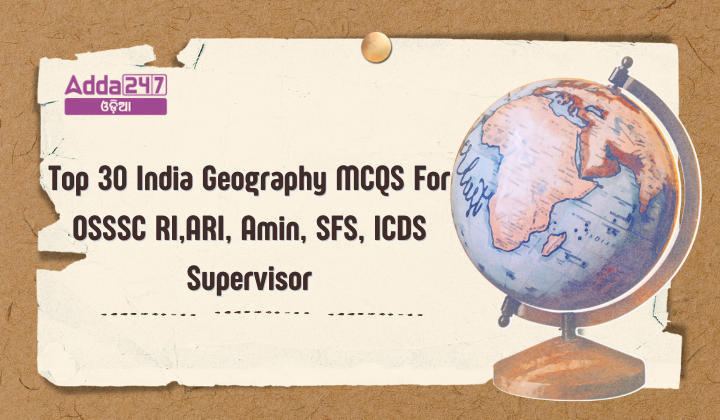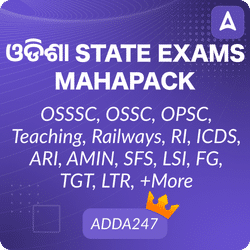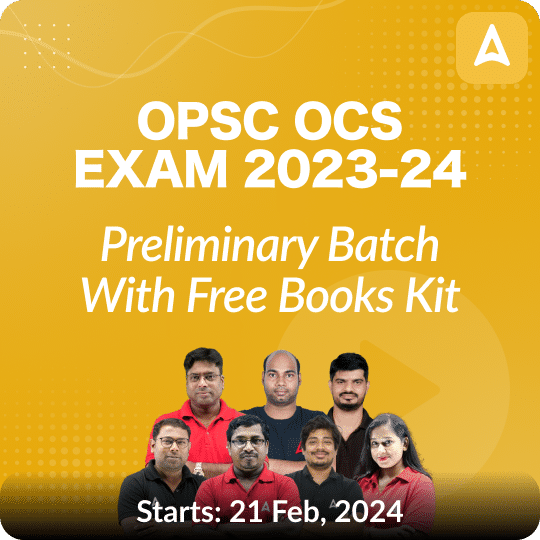IndiaGeography is a vital subject that holds significant importance in various competitive exams, including those conducted by the Odisha Subordinate Staff Selection Commission (OSSSC) for roles like Revenue Inspector (RI), Assistant Revenue Inspector (ARI), Amin, Soil Conservation Extension Worker (SFS), and Integrated Child Development Services (ICDS) Supervisor. To assist aspirants in their preparation for these exams, here are 30 multiple-choice questions covering various aspects of geography.
Top 30 India Geography MCQS For OSSSC RI,ARI, Amin, SFS, ICDS Supervisor
These multiple-choice questions cover a wide range of geographical concepts and regions, providing a comprehensive review for aspirants preparing for OSSSC RI, ARI, Amin, SFS, and ICDS Supervisor exams. Practice these questions diligently to enhance your geography knowledge and increase your chances of success in the examinations.
- Which of the following statements regarding the Geological Structure of India is/are correct?
I. Sedimentary rocks, which form fertile soil, are found in regions like the Gangetic plain due to sediment deposition.
II. During the Jurassic period, Gondwanaland fragmented into peninsular India, Madagascar, Australia, and Antarctica.
A. Only I
B. Only II
C. Both I and II
D. Neither I nor II
Ans: C. Both I and II - Which of the following is NOT one of the geological eras of Earth?
A. Azoic (Non-living era)
B. Paleozoic
C. Mesozoic
D. Cambrian
Ans: D. Cambrian - During which geological era did the continental shelf originate?
A. Neozoic era
B. Paleozoic
C. Mesozoic
D. Cambrian
Ans: B. Paleozoic - Which of the following statements is NOT correct?
A. Trophic levels represent energy levels in a food chain.
B. Primary production is relatively low in deep oceans.
C. Autotrophs are primary producers, not primary consumers.
D. Decomposers, also known as saprotrophs, break down organic matter.
Ans: C. Autotrophs are primary consumer. - What term describes the state of inactivity adopted by desert animals during the hottest and driest season?
A. Basal metabolism
B. Dormancy
C. Aestivation
D. Hibernation
Ans: C. Aestivation - Which statement correctly distinguishes between biotic and abiotic resources?
A. They are all non-renewable, with biotic resources being renewable.
B. All abiotic resources are non-renewable, but some biotic resources are also non-renewable.
C. Some abiotic resources are renewable, but biotic resources are always renewable.
D. Some abiotic resources are renewable, while some biotic resources are non-renewable.
Ans: B. All abiotic resources are non-renewable, but some biotic resources are non-renewable. - Which location is renowned for the endangered Ridley turtles?
A. Gahirmatha
B. Sagarmatha
C. Lakshadweep islands
D. Andaman and Nicobar group of islands
Ans: A. Gahirmatha - What is the primary focus of the ‘Rally for Valley’ program in India?
A. Environmental degradation
B. Biodiversity
C. Resettlement of displaced people
D. Loss of agricultural land
Ans: A. Environmental degradation - Which research program was the first to concentrate on the El Nino-Southern Oscillation and its predictability?
A. Climate Variability and Predictability
B. Global Energy and Water Cycle Experiment (GEWEX)
C. Global Change and Terrestrial Ecosystem (GCTE)
D. Tropical Ocean and Global Atmosphere (TOGA)
Ans: A. Climate Variability and Predictability - Which ministry oversees the functions of the National River Conservation Directorate?
A. Agriculture Ministry
B. Environment and Forests Ministry
C. Science and Technology Ministry
D. Water Resources Ministry
Ans: B. Environment and Forests Ministry - Which state is NOT crossed by the Tropic of Cancer?
A. Rajasthan
B. Chhattisgarh
C. Odisha
D. Tripura
Answer: C - What is the easternmost longitude of India?
A. 97° 25′ E
B. 77° 6′ E
C. 68° 7′ E
D. 82° 32′ E
Answer: C - Which country shares a common border with Indian states like Uttarakhand, Uttar Pradesh, Bihar, West Bengal, and Sikkim?
A. China
B. Nepal
C. Bhutan
D. Myanmar
Answer: B - If you choose Kavarati for a summer vacation, which Indian Union Territory are you visiting?
A. Pondicherry
B. Andaman and Nicobar
C. Lakshadweep
D. Diu and Daman
Answer: C - Which country does NOT share a land boundary with India?
A. Bhutan
B. Bangladesh
C. Tajikistan
D. NepalAnswer: C - What is another name for the Southernmost Himalayas?
A. Siwaliks
B. Himadri
C. Himachal
D. None of the above
Answer: A - What is the alternative name for the Sahyadris?
A. Aravali
B. Western Ghats
C. Himadri
D. None of the above
Answer: B - Where is the Palk Strait located?
A. Sri Lanka and Maldives
B. India and Sri Lanka
C. India and Maldives
D. Both A & B
Answer: B - Which name is popularly used for the Indian islands in the Arabian Sea?
A. Andaman and Nicobar Islands
B. Lakshadweep Islands
C. Maldives
D. Both A & D
Answer: B - Which is the oldest mountain range in India?
A. Aravali Mountains
B. Western Ghats
C. Himalayas
D. Both A & C
Answer: A - What type of drainage pattern resembles the branches of a tree?
A. Radial
B. Centrifugal
C. Dendritic
D. Trellis
Answer: D - In which state is Wular Lake located?
A. Rajasthan
B. Punjab
C. Uttar Pradesh
D. Jammu and Kashmir
Answer: D - Where does the river Narmada originate from?
A. Satpura
B. Amarkantak
C. Brahmagiri
D. Slopes of the Western Ghats
Answer: B - Which lake is a saltwater lake?
A. Sambhar
B. Wular
C. Dal
D. Gobind Sagar
Answer: A - What is the longest river in Peninsular India?
A. Narmada
B. Godavari
C. Krishna
D. Mahanadi
Answer: B - Which river flows through a rift valley?
A. Damodar
B. Tapi
C. Tungabhadra
D. Both A & B
Answer: D - What is a landmass bounded by sea on three sides called?
A. Coast
B. Peninsula
C. Island
D. None of the above
Answer: B - What are the mountain ranges in the eastern part of India, forming its boundary with Myanmar, collectively called?
A. Himachal
B. Purvanchal
C. Uttaranchal
D. None of the above
Answer: B - What is the Western Coastal strip, south of Goa, referred to as?
A. Coromandal
B. Kannad
C. Konkan
D. Northern Circar
Answer: C - What is the highest peak in the Eastern Ghats?
A. Anai Mudi
B. Mahendragiri
C. Kanchenjunga
D. Khasi
Answer: B
















